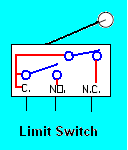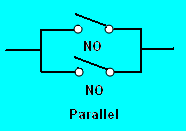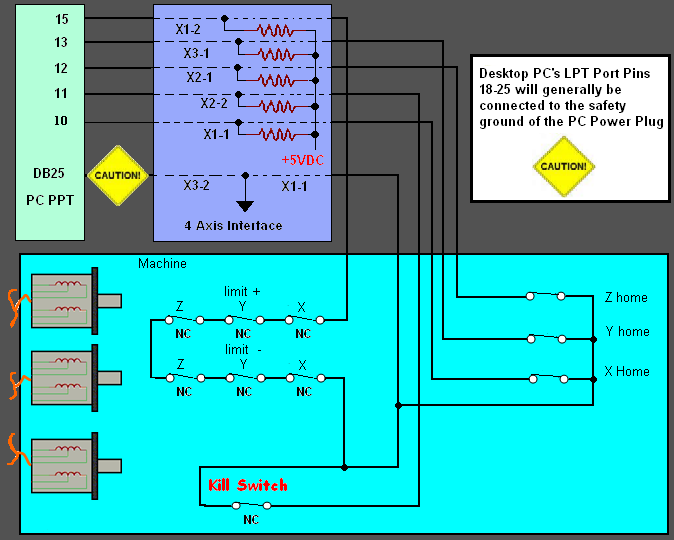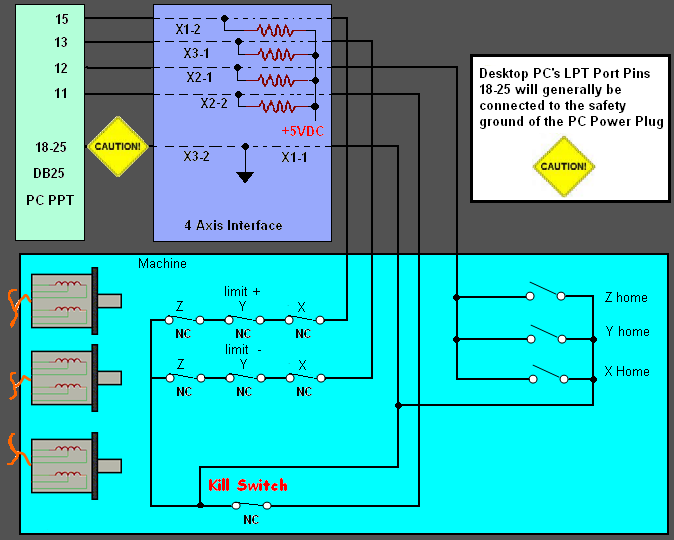Thread: Wiring home and limit switches
-
18-12-2008 #1
Wiring limits and home switches can be handled in a multitude of ways.
But first you need to know what software you plan to use before deciding on a method. Typically limit switches have both normally open contacts (NO) and normally closed (NC) contacts. Depending on how you want to wire you can wire them in series or parallel with other switches.



For example, CNCpro utilizes one input pin for each axis. Commonly that one input pin is wired to two fixed switches, one for home and the other for limit. It could also be used with one switch that moves with the axis and either via ramps or mechanical triggers actuates at the travel ends. Home is defined by the software setup as to which direction the axis is traveling when the switch activates. When using stepper motors, there typically isn't a need for more than two switches per axis. Servo's on the other hand, may need two dedicated limit switches to protect from a open loop failure causing a run away servo.
MACH3 software is very versatile and can be configured in many different ways. A common way is to have a seperate home switch for each axis, and one pin to all of the limit switches wired in series utilizing the normally closed contacts.
Below is two methods of wiring limit, home and kill switches. By utilizing a series wiring of normally closed limit switches, when one switch opens it sends a signal to the computer to stop issuing step pulses to the axis drive motors. In parallel, you have to use normally open switches to sense a switch activation. The top drawing utilizes independent normally closed switches for a home for each of 3 axis and is more compatible with MACH3. The bottom is another method to do home switches.
Utilizing normally closed switches is more noise immune, and thus reduces the risk of false switch actuation. The other noise benefit from utilizing NC contacts is coupling noise back into circuits and wiring for step/direction motor controllers.


Last edited by Lee Roberts; 18-12-2008 at 08:33 PM.
.Me
-
The Following User Says Thank You to Lee Roberts For This Useful Post:
-
21-01-2009 #2
Lee,
I am using as stated in other posts here a Stepperworld which has the ability to add switches to it on the board. I am having problems uploaing the image and will try later. The switched are labeled S4 through S6 plus ground and was wondering what would be the best way of setting up a circuit board to complement Mach3 with that set up to be able to set either boarder switches or zero points.
Thanks ahead and will try again to load the file. Does the system prefer .GIF or JPEG for uploads? As I reduced it with GIMP to 800x600 and saved it as such but it is still seeing it at the larger file size even though the file is coming from a different saved point in the drives.
Michael
-
21-01-2009 #3
Whats the file size ?
.Me
-
22-01-2009 #4
-
22-01-2009 #5
Yea the file size is set to 500k, see here: Click Me...
.Me
-
26-09-2010 #6
Hello Lee - I have just seen your wiring diagram and thought you might have a view on the following
I have just started getting the equipment together to add limit/home switches to my machine, and have found the following diagrams
The first has three wires running to all switches while the second has a serial connection to the switches which includes the emergency cutout. I can see how the second works , but am unable to see why the first has the three wires. - The connection board is the same as shown :
Are you able to comment on this set up and how it compares with your diagram
Would apprcieate anything you have to say
Thanks
Ken
-
26-09-2010 #7
The reason is that the inputs to the board have to be switched between 0v and +5v. generally the inputs are pulled up to +5v by a resistor on the board and the switches then short the input to ground. An alternative approach is to use both poles of the switch to switch the input line between a 0v wire and a +5v wire. This is how the home switches in the first diagram are wired, as individual inputs. But the same approach is used for the limit switches in the lower part of the diagram and this is just wrong... in fact the way that is wired when one limit switch is activated it puts a short from 0v to +5v, which will probably have the effect of stopping everything but for the wrong reasons.... I would ignore that and go for the single chain of switches. However I would seperate the PANIC switch from the limit switches. A panic switch should always control a relay which supplies power to the motors. That relay MAY have a contact that does the panic input to the breakout board and thence to MACH3 as per these diagrams... one should NEVER rely on MACH3 to stop the motors in an emergency, the panic switch should always act directly...
-
The Following User Says Thank You to irving2008 For This Useful Post:
-
27-09-2010 #8
Thanks Irving - I di think that the kill switch in series with the limits looked funny - effectivley actinas another limit switch and relying on the catches in the switch to keep the power off (dangerous if it failed.) so the second diagram (without the kill switch at present is the next step) - going by the other suggestions in this thread I should use NC contacts. The Home switches look like they are using separate connections with the board numbers mimicing the port outputs.
For the kill switch - would I be OK fitting that to the mains side as a breaker to cut all power to the controller and motors and leave the PC on.
Thanks
-
27-09-2010 #9
Yes the normal arrangement is to use a contactor with a low voltage (under 50v, typically 12 or 24) relay coil. The contactor is normally open, and you close it manually which energises a small transformer which provides power to the contactor coil via the kill switch, thus holding the contactor closed. Hitting the kill switch interrupts the power to the coil causing the contactor to drop out. This arrangement prevents it being re-energised accidentally in the event of a power failure. You have to manually close the contactor and it wont stay closed unless the power is on.
Another, cheaper, arrangement uses a 10A 240v NO relay (4 contacts) with a 12v coil and a low voltage transformer as used for lighting. This requires a start switch to energise the coil which is then held energised by the relay via the kill switch.
-
27-09-2010 #10
Thanks Irving for all the advice its been a great help in clearing this up - just have to put it to work now
Cheers Ken
Thread Information
Users Browsing this Thread
There are currently 4 users browsing this thread. (0 members and 4 guests)
Similar Threads
-
EMC2 home/limit switches... only acting as limit?
By vputz in forum LinuxCNC (EMC)Replies: 4Last Post: 15-10-2014, 09:51 AM -
24v Limit/Home switches. How to..?
By Wal in forum General ElectronicsReplies: 6Last Post: 17-11-2013, 05:52 PM -
Limit Switches with LED's
By manofgresley in forum General ElectronicsReplies: 30Last Post: 02-01-2013, 03:08 PM -
Limit/home switches - how are you mounting 'em?
By HankMcSpank in forum General DiscussionReplies: 2Last Post: 13-11-2011, 01:42 PM -
The best solution for limit / home switches on a mill is .....what ?
By NICKMODELMAKER in forum Gantry/Router Machines & BuildingReplies: 1Last Post: 29-05-2010, 01:38 PM










 Reply With Quote
Reply With Quote




Bookmarks